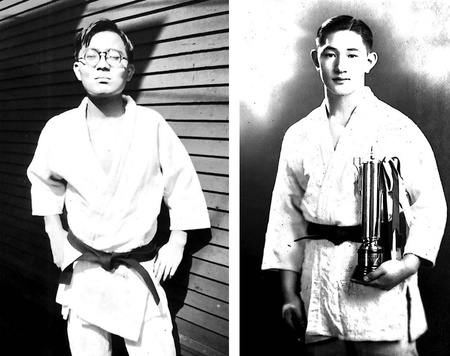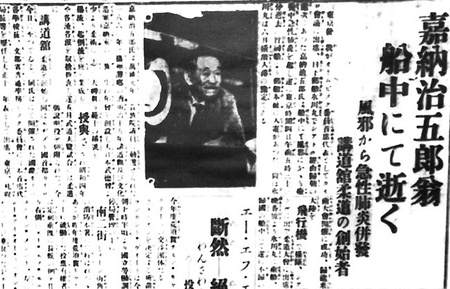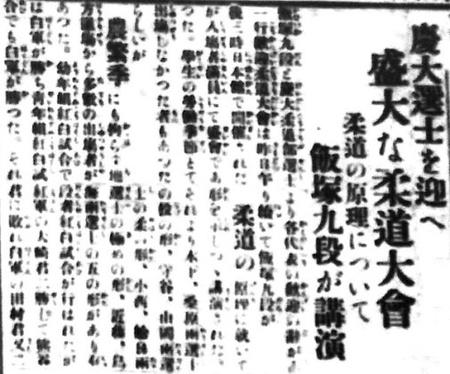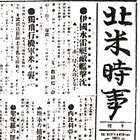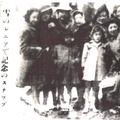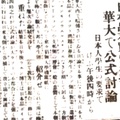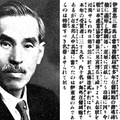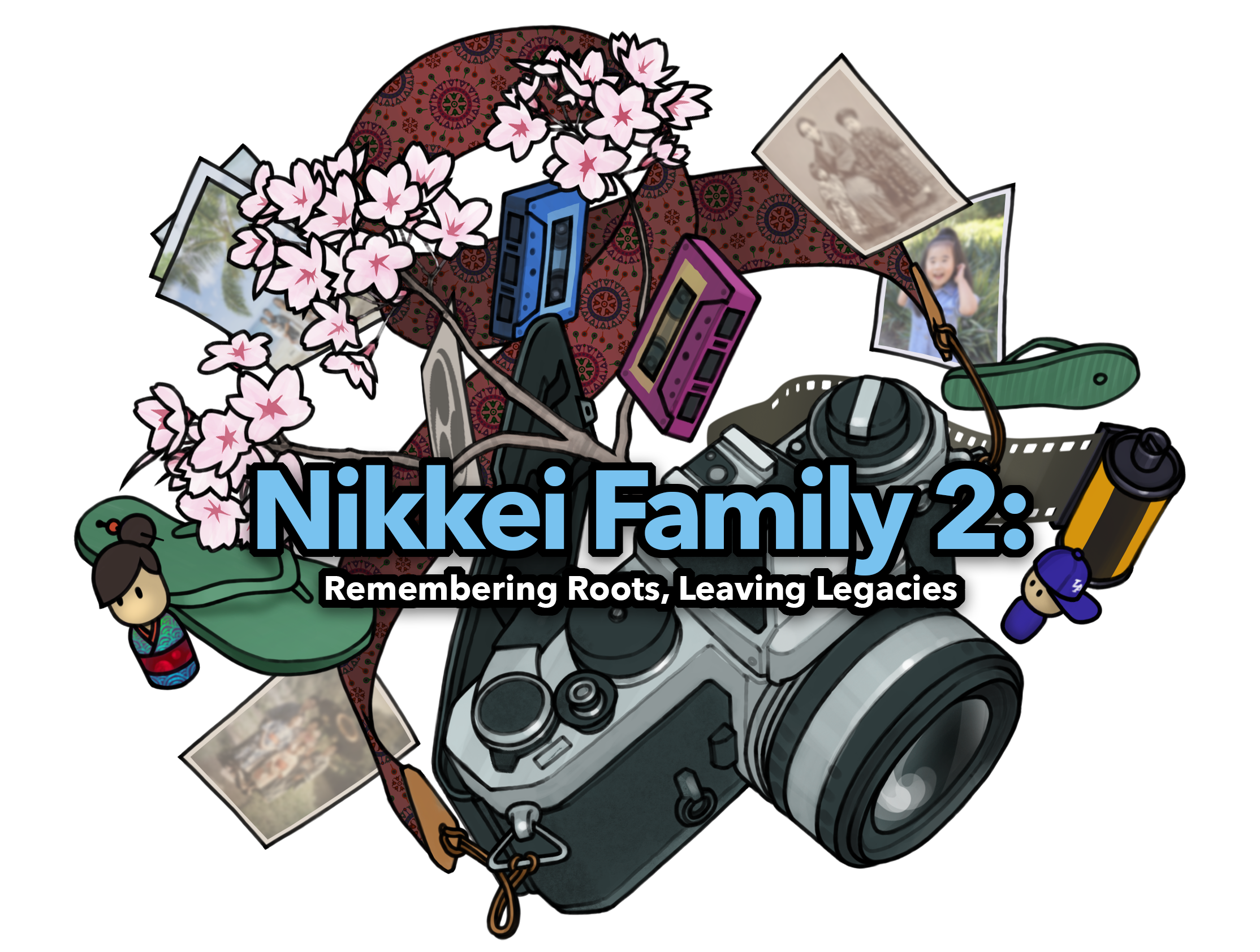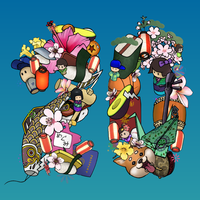Jim Yoshida’s Judo
The book, The Two Worlds of Jim Yoshida, discusses how Jim Yoshida practiced hard at judo training. In the book, Jim was into football first. He practiced judo reluctantly at first with the strong encouragement of his father, Ryunosuke. Later he found it interesting.
The article on February 7, 1938 seems to be written around that time. The article said his father, Ryunosuke Yoshida, served a councilor of Tentokukai. In February 1938, Jim Yoshida held shodan, 1st dan, but in February of the following year, he was promoted to nidan, 2nd dan. Jim also belonged to Tentokukai and I found his Japanese name, Katsumi Yoshida (18 years old at the time).
The author’s father, Atae, returned to Japan when his father, Yoemon, suddenly passed away. Atae practiced judo in a junior high school and a university under the old Japanese system and returned to the United States in June 1936. He stayed in Seattle until February 1941. During this time, Atae became close with his cousin, Jim Yoshida.
Atae practiced judo with Jim. He recalled that Jim was quite strong. Atae possessed a photograph of Jim Yoshida wearing a judo uniform and a photograph of himself in a judo uniform, which were thought to have been taken around 1938 or 1939.
The article below describes that Jim Yoshida, as a representative of Tentokukai, introduced judo to the University of Washington and received great applause.
“Introducing Judo at the University of Washington” (February 15, 1939)
On the night of December 11, the basketball games between the University of Washington (UW) and the Washington Ecoute College took place at the UW Pavilion. Yoshida 2nd dan and Koiwai 1st dan from Tentokukan Dojo had a judo demonstration with the exlnatation by Mr. Sakahara is in front of the microphone. They received a great ovation.
Jigoro Kano Visited Seattle
The March 8, 1938 issue reported that Jigoro Kano, who was in charge of the Tokyo Olympics Preparatory Committee at the time, arrived in Alexandria in Egypt to attend the Cairo Conference and he expressed his strong determination to hold the Tokyo Olympics no matter what. After the Cairo Conference, Kano visited Seattle on his way home.
“Jigoro Kano Arrives by Airplane Tomorrow Morning” (April 18, 1938)
Jigoro Kano, who had attended the Cairo Conference of the International Olympic Committee as a representative of Japan, is scheduled to arrive in Seattle at 11:30 a.m. tomorrow by plane. Seattle Judo Yudansha Kai was in the midst of meeting to prepare for the welcome. They made the following announcement.
“Arriving on the 19th, Kano sensei will stay at the Olympic Hotel. From 7 p.m., there will be a meeting with dan-holders. In the afternoon of the 20th, a reception will be held. On the night of the 21st, a banquet will be held. He will return to Japan on Hikawa-maru on the 22nd.”
“Welcome Party and Judo Tournament for Jigoro Kano” (April 21, 1938 issue)
The welcome party for Jigoro Kano was held at 7 o’clock last evening at Gyokkoken. Deputy Consul Sato, Secretary Nakazawa, dojo members, parents, and many others attended. Kumagai shihan served as an emcee. Welcoming remarks were made by Mihara who represented Nissho (Japan Chamber of Commerce and Industry), newspaper representative Arima, and Deputy Consul Nakazawa.
After the meal, Mr. Jigoro Kano reported about the Cairo Conference and explained the reason for changing his schedule to suddenly return to Japan was to take care of remaining issues related to the Olympic Games and to start the work of the Hokoku Koseidan. After that, the judo competition was held in Washignton Hall to welcome Kano shihan.
Jigoro Kano had a valuable speech, which was summarized below.
“Judo is based on jujutsu, but it is not just a matter of refining the technique. It’s about applying the principle that has been learned based on a single principle in all areas. What you are doing right now is to make your body strong and learn techniques. Practicing judo, however, is first, to make your body healthy; second, to make your body strong; and third, to utilize such techniques. Judo is a way to win over people in case of emergency and create the power to stay calm so that I believe judo is the best thing in the world… Luckily, Mr. Sakata and Mr Kumagai, who live here, are excellent masters, and I hope you will continue to work hard in the future.”
The results of the Kohaku matches are shown on the left (the names of the winners of the youth and those with ranks are listed).
The issues of April 2 and 22, 1938 published articles about Hokoku Koseidan, giving detailed explanations by Mr. Jigoro Kano, president of the Kodokan and president of the Kodokan Culture.
“Mr. Jigoro Kano Passes Away on the Ship” (May 4, 1938 issue)
Mr. Jigoro Kano, who attended the Cairo Conference as the chief representative of Japanese Olympic Committee, was on the way to Japan via Seattle. On the ship, Hikawa-maru, he caught a cold and developed acute pneumonia undergoing treatment.
At 5:23 a.m. on May 4 at Tokyo time, Yusen Headquarter received a telegram from the ship, stating that he had passed away. The Hikawa-maru is scheduled to enter Yokohama port on the 6th.
Mr. Jigoro Kano was born in 1860 in Hyogo Prefecture to the Kano family of sake brewers. He began studying jujutsu at an early age and eventually started Kodokan Judo, which continues to this day. He served as the president of various schools and the director of primary education for the Ministry of Education. He was elected as a member of the House of Peers in 1922. …
On the way back from the Cairo Conference, he flew across the US continent and went to Seattle to attend a judo competition. He boarded the Hikawa-maru from Vancouver. On the way back to Japan, he passed away on ship at the age of 78.”
“Mr. Jigoro Kano’s Body Arrives in Yokohama Today” (May 6, 1938 issue)
The Yusen Hikawa-maru, carrying the body of Jigoro Kano who died suddenly on his way back to Japan, arrived at Yokohama Port at 3:00 p.m. on the 6th, sadly with the stern flag at half-staff. The 79-year-old Kano, who is considered the father of sports in Japan, departed from Tokyo in good spirits on February 16 to secure the holding of the Olympic Games in Tokyo. He played an active role as the chief representative of Japan at the IOC General Assembly in Cairo. Although he supposed to be greeted with cheers from the whole nation as a souvenir of the great success of securing the Tokyo Olympic Games, his triumph return now became a sad, silent one.
Keio University Judo Club Comes to Seattle
“The U.S. Expedition team of Keio Judo Club” (June 7, 1938 issue)
Despite of increasing concerned about the recent deteriorating relations between Japan and the United States, the Juyukai, which is the senior group of the Keio Judo Club, has decided to organize an expedition to the United States through the support of Mr. Aratani, who lives in the United States. On June 23, the Club will depart from Yokohama on the Yusen Ryuo-maru, and land in San Francisco on July 7.
The club athletes will visit various universities in the western United States for about a month and a half. They are eager to contribute to the goodwill between the U.S. and Japan. The members of the expedition team are shown on the left. The group leader is Iizuka, a 9-dan holder (student names are listed below).”
An article reported the arrival of the Keio University judo club group in Seattle from San Francisco.
“A Grand Judo Competition with Keio Club members” (August 8, 1938 issue)
The welcome judo competition was held at the Nippon-kan Hall at 3 p.m. yesterday to welcome Iizuka with 9-dan and the Keio University judo club members. I was a great success with a full audience. It seems that some students did not participate due to the labor season for student, but there were many participants from the countryside despite the busy farming season. The white team won at the junior kohaku match; they also won at the youth Kohaku match.
Then, there were welcome speeches from each representative, followed by Iizuka, 9-dan holder. He gave a lecture on the principles of judo, demonstrating the forms. (The names of the participants are listed below.) After that, prizes were awarded, and the competition closed after 12:00 midnight.
In addition, the group will tour the dojo at 11:00 this morning. Then, at 3:30 p.m., they will demonstrate judo at the University of Washington. They will attend a tea party at the consulate's residence afterward.
Tomorrow they will leave the hotel at 11 a.m. and plan to climb Mount Rainier. After returning to Seattle, they will attend the welcome party hosted by Mita Kai. The day after tomorrow they will spend the day in Leinslaw.
Many Japanese judo practitioners, including Jigoro Kano, tried to teach judo to Nisei men in Seattle as a form of Japanese mental training. These articles show that many Nisei men were interested in judo as a Japanese sport and were enthusiastically practicing it. Jim Yoshida was one of them.
Next chapter will introduce articles about kenjinkai, which served as an important role to united Japanese living in Seattle.
*Excerpts from articles include summaries from the original text.
Note:
1. All article excerpts are from The North American Times unless noted otherwise.
References
Kazuo Ito, 100 Year Cherry Blossoms in North America, Nichibo Shuppan, 1973
Hokubei Jijisha, Hokubei Nenkan, 1928
Zaibei Nihonjinkai Jiseki Hozonbu hen, Zaibei Nihonjin Shi, 1940
Jim Yoshida, Bill Hosokawa, Jim Yoshida’s Two Homeland,” Bunka Shuppankyoku, 1977
*The English version of this series is a collaboration between Discover Nikkei and The North American Post, Seattle’s bilingual community newspaper. This article was originally publishd in Japanese on September 27, 2022 in The North American Post.
© 2022 Ikuo Shinmasu


